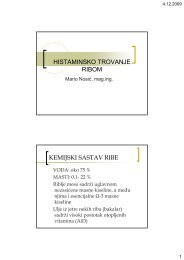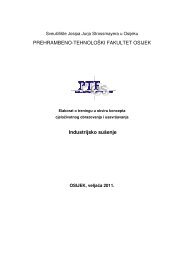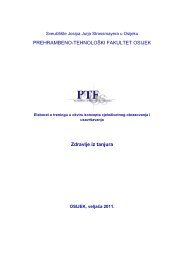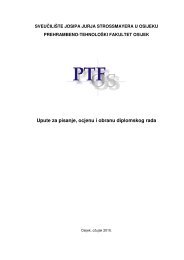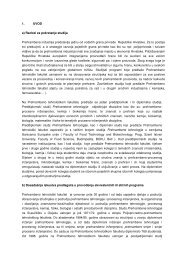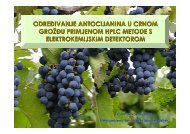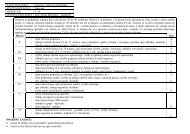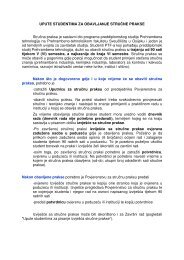ENGLISH IN FOOD TECHNOLOGY I
ENGLISH IN FOOD TECHNOLOGY I
ENGLISH IN FOOD TECHNOLOGY I
You also want an ePaper? Increase the reach of your titles
YUMPU automatically turns print PDFs into web optimized ePapers that Google loves.
UNIT 7<br />
WHOLE HEALTH FOR SELF- CARE – A NEW NUTRITION?<br />
Activity 1<br />
1. Are people interested in self-care? Why?<br />
2. What are the potential sources of learning about food and health?<br />
I remember when mothers used to say, “Clean your plate, many children are starving<br />
today”. Today too many people apparently clean their plates, too many times. The rise in<br />
obesity in the United States is a growing concern. Simultaneously, there has been a<br />
widespread movement toward purchasing food and nutrition products that contribute to whole<br />
health, a self-care approach to preventative self-care. More and more people today actively<br />
seek to learn about nutrition and how the food they eat will influence their health. Nearly 90%<br />
of consumers in the survey say that their food purchases are influenced by health concerns<br />
and their belief that eating a better diet can reduce serious health risks.<br />
The FMI study asked about general health concerns relating to motivation for self-care.<br />
The top four concerns were:<br />
1) managing or treating a specific health condition on your own;<br />
2) reducing the risk of a specific health conditions;<br />
3) following advice of a doctor;<br />
4) avoiding artificial preservatives or additives.<br />
The primary health concerns included problems with cholesterol, diabetes, heart diseases,<br />
high blood pressure, weight loss. The quest for self-care is apparently being driven by<br />
deteriorating confidence in the medical care system in the United States and by its active<br />
promotion of self-care and health information. Consumers are more actively seeking<br />
information about the relationship between the foods and they eat and their health. The<br />
Nutrition Fact Label on foods is also being used by more consumers than ever, and foods are<br />
being dropped or added to the shopping cart based on what is being learned from reading<br />
labels. This proactive control of foods in the diet increases with income and education and is<br />
greatest for those who are college educated and earn more than $50.000 a year. Types of<br />
information sought by many consumers relate to the importance of fibre intake and benefits of<br />
herbal products, protein, soy and reducing salt intake. The primary sources of information<br />
being used are magazines, books and Internet.<br />
Even though consumers say they seek more information and sometimes act on it in<br />
adding or dropping foods from their diets, when asked what they buy to maintain their health<br />
79% reported vitamins and minerals and other over-the-counter medications, 72% reported<br />
prescription medications and 73% reported fortified foods. About 50% of consumers buy<br />
foods without artificial additives or preservatives and about 38% buy herbal remedies and<br />
organic food. Perhaps this accounts for the double- digit annual growth in the sale of organic<br />
products and functional foods over the past five years. They have carved out considerable<br />
niches in the food market with organic sales reaching about $8 billion and functional food<br />
sales reaching about $1.3 billion.<br />
With a plethora of health and nutrition information available in the media and on food<br />
labels, its use being promoted by the health care system, why do we find so much evidence of<br />
poor diets? Three reasons predominate: it costs more to eat healthy; healthy foods do not taste<br />
22



